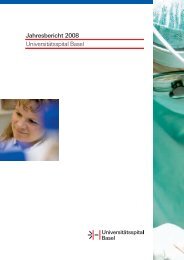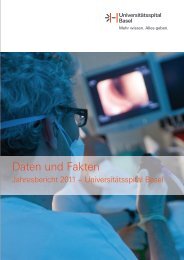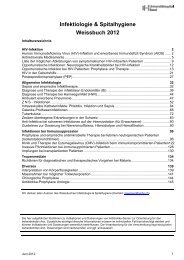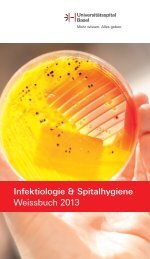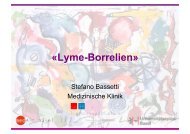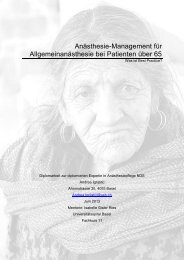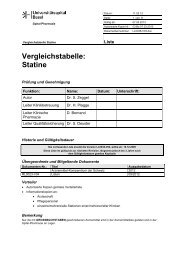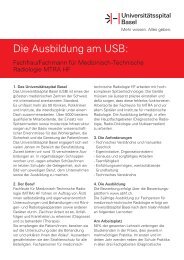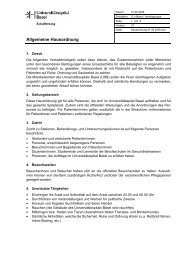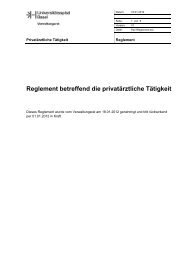Transmucosal Nasal Drug Delivery: Systemic Bioavailability of ...
Transmucosal Nasal Drug Delivery: Systemic Bioavailability of ...
Transmucosal Nasal Drug Delivery: Systemic Bioavailability of ...
Create successful ePaper yourself
Turn your PDF publications into a flip-book with our unique Google optimized e-Paper software.
8 Overall discussion<br />
pharmacokinetic characteristics to provide midazolam therapy in clinical situations where common<br />
drug delivery methods (e.g., i.v. or i.m. administration) are inappropriate but fast onset <strong>of</strong><br />
therapeutic effect is required (e.g., anticonvulsive treatment <strong>of</strong> status epilepticus).<br />
In particular, the tested chitosan hydrochloride containing nasal midazolam preparation<br />
(Preparation 5) demonstrated fast increasing <strong>of</strong> midazolam serum concentration providing maximal<br />
midazolam serum concentrations within 7.1 ± 0.6 minutes (range t max 1.9 min). These findings are<br />
in accordance with the data published by Illum demonstrating chitosan to promote nasal absorption<br />
<strong>of</strong> morphine [Illum, et al. 2002]. Furthermore, nasal morphine preparations containing chitosan<br />
provided fast onset <strong>of</strong> therapeutic effect in the treatment <strong>of</strong> breakthrough pain in cancer patients<br />
[Pavis, et al. 2002]. As well as therapy <strong>of</strong> breakthrough pain, treatment <strong>of</strong> seizures (epileptic or<br />
febrile) is also a clinical situation where drug administration is difficult and fast onset <strong>of</strong> therapeutic<br />
effect is urgently needed.<br />
Chitosan containing nasal midazolam preparation (Preparation 5) showed most promising<br />
pharmacokinetic characteristics for the treatment <strong>of</strong> seizures. Providing anticonvulsive therapy by<br />
nasal administration <strong>of</strong> midazolam the local irritation is <strong>of</strong> secondary importance compared to the<br />
enormous benefit <strong>of</strong> this needle-free drug delivery option featuring rapid onset <strong>of</strong> therapeutic effect.<br />
However, to elongate shelf life and to reduce local irritation further optimization <strong>of</strong> chitosan<br />
containing nasal midazolam preparations is required.<br />
The performed pharmacodynamic testing during Project II (VAS and CRTT) assessed volunteer’s<br />
attention and their ability to respond. These tests aimed predicting the time needed to restore<br />
fitness to drive after procedural anxiolysis with nasally applied midazolam. However, for the<br />
quantification <strong>of</strong> the anticonvulsive effects <strong>of</strong> nasally delivered midazolam more specific<br />
pharmacodynamic characterization needs to be performed (e.g., electroencephalogram).<br />
To assess the anxiolytic effects <strong>of</strong> benzodiazepines in healthy volunteers, different testing methods<br />
have been described in literature [Visser et al., 2003]. But no testing method is specific enough to<br />
differentiate sedating from anxiolytic effects. Anxiety and panic during MRI examinations is<br />
impossible to be simulated, since these phenomena involve different components (e.g., fear <strong>of</strong><br />
enclosed places, pain, the unknown situation, as well as apprehension about what the test might<br />
reveal) [Katz, et al. 1994]. Consequently, evaluation <strong>of</strong> therapeutic equivalence <strong>of</strong> two nasal<br />
midazolam preparations was accomplished with anxious and/or claustrophobic patients undergoing<br />
MRI examinations and not with healthy volunteers (multicenter trial, Project III).<br />
Therapeutic equivalence <strong>of</strong> multidose nasal spray (MD, Preparation 1) and unit dose nasal spray<br />
(UD, Preparation 3) demonstrated in Project III is in accordance with the congruent serum<br />
concentrations time pr<strong>of</strong>iles attesting bioequivalence for these two preparations.<br />
However, less required additional doses (total administration <strong>of</strong> 2 mg midazolam) in the comparator<br />
group (UD, Preparation 3) cannot be explained by serum concentration time pr<strong>of</strong>iles. <strong>Drug</strong><br />
administration with the unit dose system (UD, Preparation 3) is mostly a new experience for the<br />
patients, while nasal drug administration with the multidose nasal spray (MD, Preparation 1)<br />
resembles ordinary nasal delivery <strong>of</strong> common decongestants for the treatment <strong>of</strong> rhinitis. The<br />
Katja Suter-Zimmermann Page 98 <strong>of</strong> 188 University <strong>of</strong> Basel, 2008




